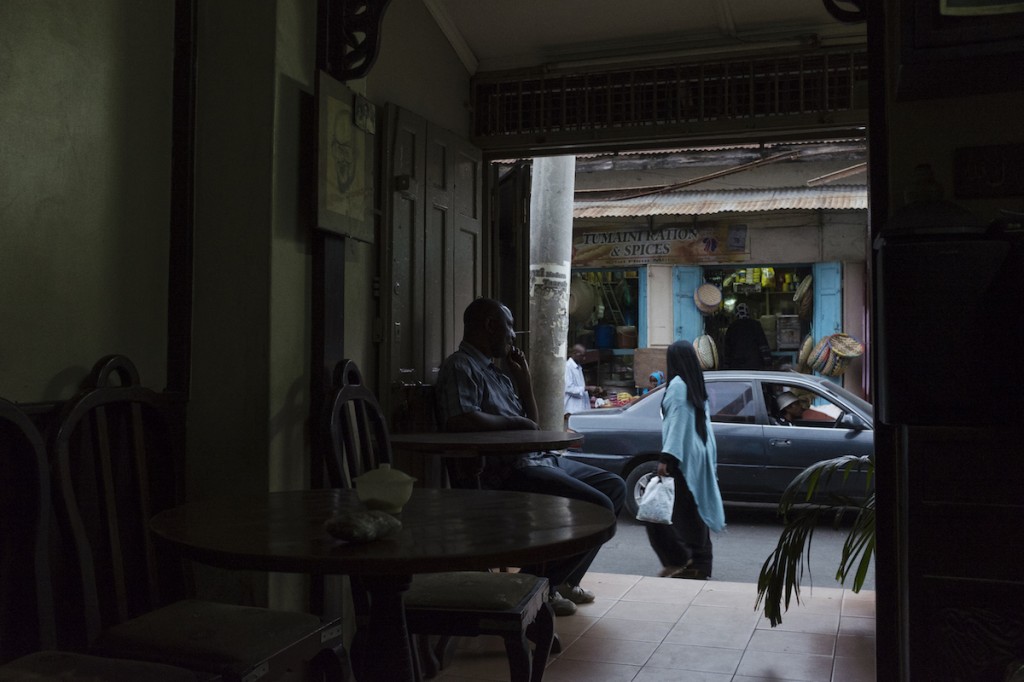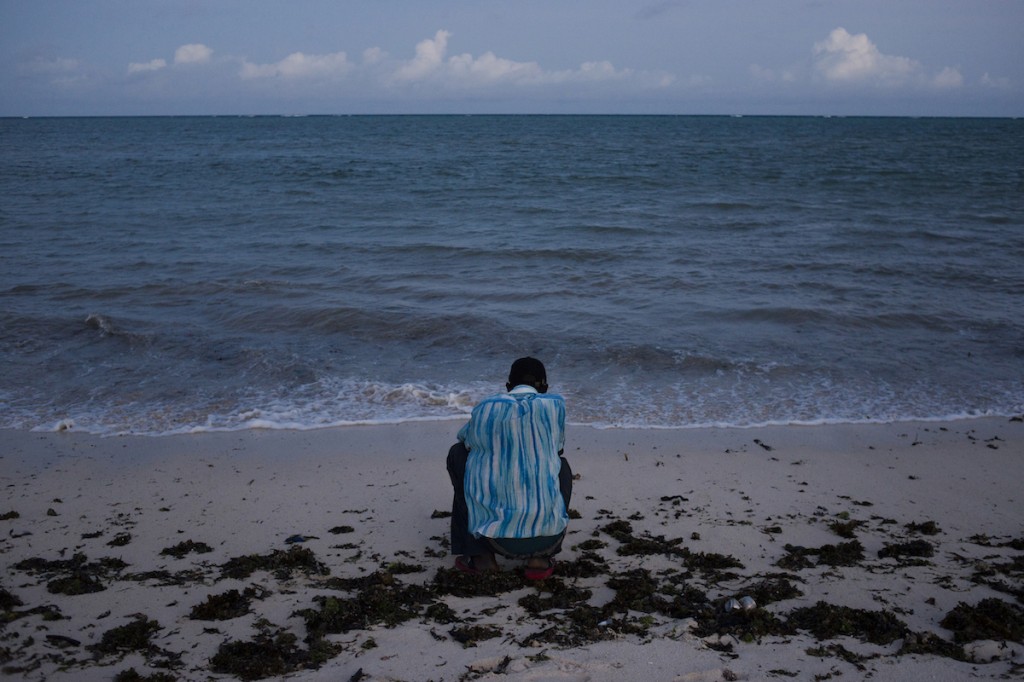At 4 p.m., my ferry reached the southern shore of Mombasa, the Kenyan port city of roughly 1.2 million people. Martin, my fixer, was in the driver’s seat. He had agreed to take me to meet a man who had defected years earlier from Al Shabaab, a radical militant group and arm of Al Qaeda in Somalia. After the ferry docked, we drove out to the street, snaking through a crowd of passengers before veering onto winding back roads. We pulled up to a white mosque. The street was empty. Even a nearby video-game shop, whose doors were adorned with a painting of the Playboy bunny wearing a Nintendo controller as a tie, was deserted. The back door of the car opened, and a man got in. “Take a left here,” he told Martin.
We followed a dirt trail and soon arrived at a beach, where boys played football, young couples canoodled in their cars, and middle-aged women sold bottles of lukewarm water and old biscuits.
The man in the car, whom I’ll call Malik, opened the door and walked toward the beach. He lit up a cigarette. Martin motioned for me to stay put. I asked where he was going. “Now,” said Martin, “it is time to persuade him.”
Since 2011, when Kenya entered the fight in Somalia against Al Shabaab, terrorist attacks have increased throughout the country. The most deadly and publicized occurred in 2013 at the Westgate Mall in Nairobi, where gunmen killed at least sixty-seven and injured 175; and in 2015 at Garissa University, where 148 Christian students were separated from their Muslim peers and executed. Mombasa had a number of relatively low-casualty grenade attacks in the past two years, but other towns on the coast have suffered more: in June 2014, Al Shabaab militants crossed the border to the predominantly Christian town of Mpeketoni, killing some sixty people in a massacre that lasted over three days.
Mombasa is an amalgam of cultures and religions: churches share neighborhoods with mosques, and Sanskrit flags mark Jain and Hindu temples hidden by the trees. In the city’s Old Town, a heady aroma of East African, Indian, and Middle Eastern cuisine wafts from the doorways. Calls to prayer sound alongside rap pounding from dance clubs and bars, attendees of both moving with fervent devotion. While most Kenyans accept the virtue and vice present in Mombasa, it has attracted attention from zealots. On May 15, 2012, a man named Thabit Jamaldin Yahya lobbed three hand grenades into one such nightclub, Bella Vista, killing one woman and wounding five others. Yahya was sentenced to death in March of this year.
Kenya’s northern coast is a popular location for Al Shabaab to recruit followers. “We were advised by a man who is now dead,” said Malik, recalling his own recruitment eight years earlier. “He advised us about our religion. Said that we should go fight for God. They also promised us things—a salary to send home to our families, food, shelter, a good life. None of it was true.”
Malik did not strike me as the type of man who would have been with Al Shabaab. Unlike many conservative Muslim men in Kenya—who grow chinstrap beards, wear the traditional thobe, and have the pious zabiba prayer mark on their foreheads—Malik looked altogether secular. He was wearing a blue-striped button-up shirt, worn cargo pants, and red flip-flops. He spoke calmly, moved purposefully, and rarely glanced my way. Malik appeared at least a decade younger than his thirty-six years, his face remarkably unlined and at peace for someone who spent five years fighting the Kenyan and Somali militaries.
“I met my wife in the madrasa,” he said, referring to the school where young Muslims learn the principles of their religion. “She wasn’t happy when I left, but it was my decision.” He smiled.
Malik told me he left his family and community not only because he was convinced Al Shabaab’s cause—instituting their version of religious law and expelling the foreign forces of Kenya’s Christian government—was for good, but because underemployment had left him in a tough spot. Like many young Kenyans, he struggled to find work. He picked up day jobs in construction and hailed passengers for a matatu (a gaudily painted bus, the only public transport in Mombasa aside from motorcycles), standing in the open door, calling out the stops, and taking the ride fee, for which he earned about twenty dollars each week. For young men in Mombasa and the greater Swahili Coast, the promises from Al Shabaab can be irresistible.
Young Muslims in Kenya often feel their religion is under attack. In a 2014 report conducted by the Institute of Security Studies, 65 percent of former Al Shabaab recruits interviewed cited “collective punishment” tactics, such as assassination of clerics and raids on mosques, as their reasons for joining the group. The conservative neighborhood of Majengo is regularly subject to such government raids, with Kenyan security forces rounding up young Muslim men from the streets and mosques, arresting anyone who is not carrying identification. According to Kenyan journalist Martin Mwaura, mosques are common targets for police, especially one in the city’s center, called Masjid Musa. It is known for its radical preaching and inciting youth to join Al Shabaab. Masjid Musa was raided in 2014, and, Mwaura told me,“they found grenades, machetes, and AK-47s”
Malik shifted from one foot to another, looking out at the young boys playing football by the beach. The sun was setting, throwing light on his face through a clearing in the trees where he had insisted we park. “In our community, you can be isolated,” he told me. “You’re perceived as weak. The people will say, ‘Well, ten others went [with Al Shabaab], why don’t you? Are you not man enough?’”
Last year, the Kenyan government announced it would grant amnesty to any Kenyan Al Shabaab recruit who returned voluntarily. It posted phone numbers and a Gmail address online for men who wished to have their records wiped clean and to return to their families. An article by Rasna Warah in The Daily Nation, a local large-circulation newspaper, claimed that “as many as 700 former Al-Shabaab youth from the coastal counties of Kwale, Kilifi, and Mombasa returned home this year but were afraid to join the government’s rehabilitation programme as they feared that they might also ‘disappear’ or be killed.”
Malik left Al Shabaab in 2013, before the announcement of amnesty. He realized early on that the promise of a good salary and a glorious reception among locals wasn’t real; but he had to wait five years before he found a way out. Malik and fifteen others spent three months planning their escape. Each day they observed who went where, got to know through word of mouth which families in the area were sympathetic to defectors and could hide them, saved as much money as they could, and calculated how long they could survive on little food. Eventually, they crossed the Kenya-Somalia border in the desert, through what he called “panya routes,” or “rat routes,” where they wouldn’t be seen.
“We left the area at night. We could hide out in homes; some would sympathize and hide us for a few days and give us food. There was one who said we could stay, but we knew he was going to betray us. We left, and they [Al Shabaab] came just hours later.”
I asked him why he finally decided to leave.
“I saw things there that . . . I saw things that were not particularly right. To me, for some sins, God will deal with you harshly, because they are just not right.” Malik believed himself to be a fair person of good judgment. “If there is a thief, do you cut his hand because that is the law, or do you spare him because he was just trying to feed his son? The justification for violence is based on different scenarios.” Yet not everyone in Al Shabaab had such discretion. He described how the leadership would take young men who came to the group because of peer pressure, brainwash them with teachings that were not true to Islam, and recruit them for suicide bombings, killing scores of civilians. Malik faced crises of conscience every day: he was too liberal, it seemed, for the militant leadership, and too conservative for Kenyan society. “Some bombings are justified. If there are men and women dancing together, sinning, it is fine,” he said, referring to the Bella Vista bombing of 2012. “But with women and children . . . I could never go through with it. They were innocent.”
Malik remembered how, when a fight would break out in town, the cries of children would keep him awake at night. He tried to be kind with them when he could, giving the ones who were starving from famine the little food or money he had from the nearly nonexistent salary from Al Shabaab. “That was my small way of doing some good.”
Though Mombasa is Kenya’s second-largest city, its outdoor cafes, its residents’ habit of chewing miraa (a stimulant leaf used by many Kenyans) in the suffocating afternoon heat, and the close proximity in which its working class live their lives all conspire to help word travel quickly. This is why Malik and others came home quietly. He feared not only for himself but for his family, who had already been subject to questioning in his absence. While his wife and family were happy for him to return, the surrounding community was not so welcoming. Fearing guilt by association and arrest by authorities, they isolated him. “Most who come back, come back radicalized. I am not like that. I didn’t really change. Still, I’m not consulted in community affairs, I’m excluded from decision-making. In this country, if you’re a Muslim, you’re looked at as a terrorist.”
Before I left Malik, I asked to take his photo. He smiled a bit and rubbed his forehead. “According to our training [in Somalia], having our photo taken was the worst thing that could happen to us. . . .” he trailed off.
Still, after a few words, he consented to be photographed, provided his face wasn’t shown. He tied his shirt around his entire head, obscuring even his eyes, and crouched beneath the trees. He huddled into a small ball behind the branches. I suggested we take one more on the beach, even though the sun had already set. He looked around, and seeing that most of the beachgoers had departed and that the young boys were busy with their football game, he said okay. I took a few photos of him standing and a short video clip before he crouched into a ball once again, picking at the larger rocks in the sand.
“I forgot to ask you earlier,” I said, as we walked back to the car, “What is your favorite place in Mombasa?”
Looking back at the water he answered, “Here.”
While we made our way back to the ferry, he asked to see the photos. I handed him my camera. I saw him in the rear-view mirror, the light from the camera illuminating his face as he silently clicked through the photos in the backseat. He handed it back and stepped out of the car. “Thank you,” he said with a smile. He shook my hand and slipped away silently into the crowd. I flipped through the camera’s photos. Malik had deleted most of them, save for a single image: he was crouched by the beach, as small as possible, the blue vertical stripes on his shirt crossing the lazy waves rolling onto the sand.
Enjoy this Postcard? Subscribe to Harper’s Magazine today!






